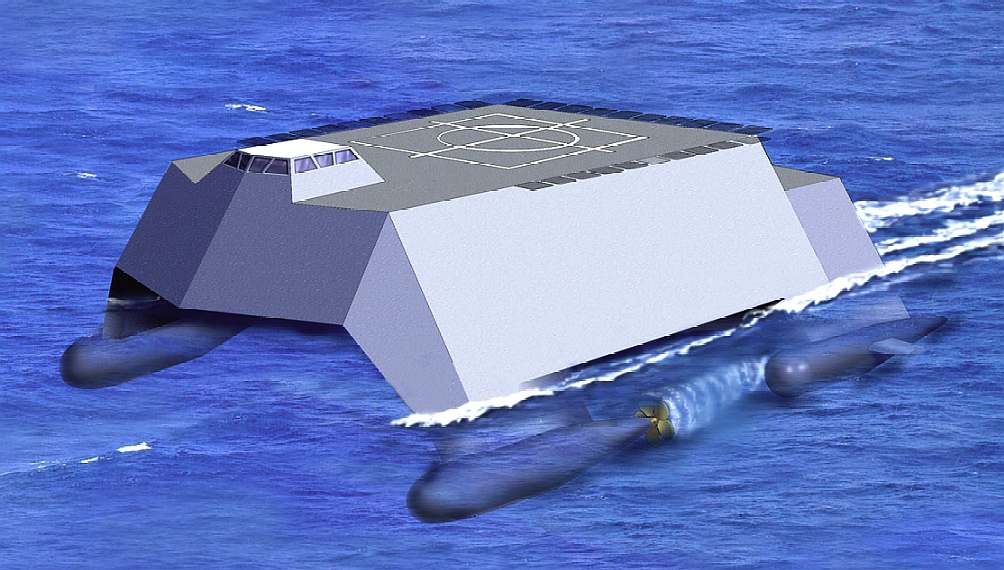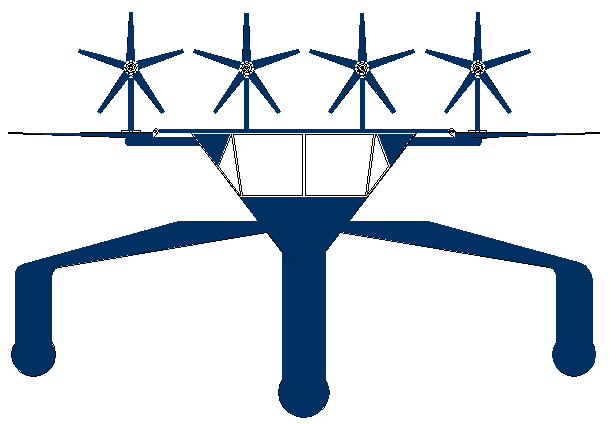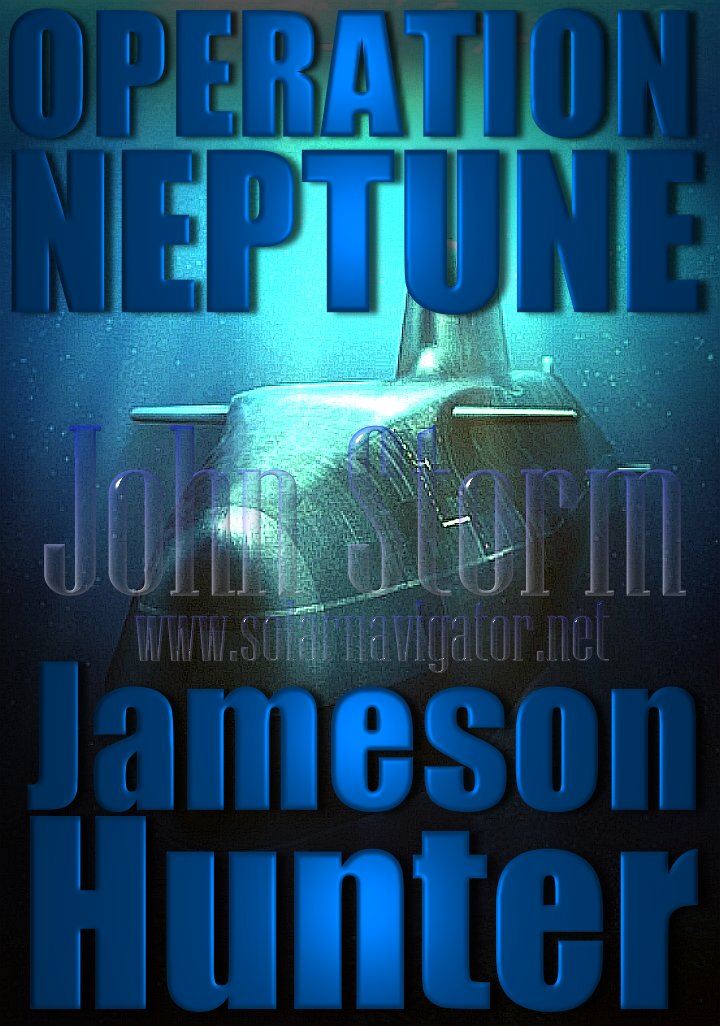|

2004
- New technology will help the U.S. Navy construct an all-electric warship that will revolutionize the use of weaponry and manpower.
It looks similar in concept to the Espandon Swordfish, though larger.
The Navy is developing an electrical warship that will draw all of its power from an on-board nuclear power plant, but it unfortunately looks nothing like Captain Nemo's Nautilus, which also ran on electric power. However, it does look a hell of a lot like the stealth ship from the James Bond flick Tomorrow Never Dies, meaning that the Navy is turning to ten-year-old Bond films for inspiration.
The electric warship's system architecture to be designed by Cemal Basaran, director of the Electronic Packaging Laboratory in the School of Engineering and Applied Sciences, and other researchers working on the project for the Navy will make available throughout the entire ship onboard electric power generated by the ship's power plants and mechanical propulsion system.
Standard shipboard electrical systems currently are unable to distribute this immense electrical power to all parts of the ship, making impractical the use of advanced weapons and sensors that require a lot of power, according to the Navy.
Increased power availability will lead to computerization of most of the electric warship's operations, which will make manpower redundant. The electric warship will require a crew of 100, compared to the traditional battleship crew that numbers in the thousands, according to Navy estimates.
The Navy plans to have the electric warship operational by 2012.
Basaran, under a $500,000 Navy grant, will design next-generation power electronics capable of carrying high-current density and high power to all parts of the warship, using nano- and microelectronics technology. This will be a critical component of the ship's system architecture, Basaran says.
"The next-generation power electronics that will control the ship will lead to major improvements in effectiveness, survivability and cost savings, as well as a significant reduction in the size of the vessel's components," he adds.
Basaran and co-researchers in the Electronic Packaging Lab are renowned for their pioneering work in designing and testing micro- and nanoscale electronic packaging. Their work, already in use by companies such as Intel, has helped produce smaller, faster and longer-lasting electronic devices at much lower cost. They have developed advanced computer models to simulate and predict electronic packaging fatigue life and reliability under extremely harsh service conditions, such as in a Navy warship.
"Our job is to design and test for the Navy micro- and nanoscale electronic packages that maintain reliability under extremely harsh conditions resulting from concurrently acting vibrations, high-current density, high power and high-temperature loads," says Basaran, an associate professor in the Department of Civil, Structural and Environmental Engineering.
"The state-of-the art electronic packaging technology cannot handle the huge electrical power needed by an electric ship's warfare and civilian components in micron and nanoscale packages."
The warship's integrated electric system will reduce significantly size and electrical-power consumption presently occurring in traditional Navy ships. By significantly shrinking the size of a ship's power components, the Navy will free up onboard space that can be used for other functions, according to Basaran, a recipient in 1997 of the U.S. Navy Office of Naval Research Young Investigator Award.
"Right now, most electrical components are huge and waste too much power, but they don't need to," Basaran says. "We can reduce their size and waste by orders of magnitude, while increasing their ability to handle high current-density and high-power levels in harsh environments, significantly."
Navy funding and collaborating funding from the New York State Office of Science, Technology and Academic Research (NYSTAR) and corporate grants will fund the work of six doctoral students on the project, according to Basaran.
http://io9.com/337753/an-all+electric-navy-warship
An all-electric warship is under development by the U.S. Navy; the work is being supervised by Cemal Basaran, director of the
Electronic Packaging Laboratory in the University of Buffalo School of Engineering and Applied Sciences.
The intent of the project is to make the full electric power of a nuclear plant available throughout the ship. Increased power availability will lead to computerization of most of the electric warship's operations, which will make manpower redundant. The electric warship will require a crew of 100, compared to traditional battleship crew that numbers in the thousands, according to Navy estimates.
The next-generation power electronics that will control the ship will lead to major improvements in effectiveness, survivability and cost savings, as well as a significant reduction in the size of the vessel's components." said Basaran.
"Right now most electrical components are huge and waste too much power, but they don't need to," Basaran says. "We can reduce their size and waste by orders of magnitude, while increasing their ability to handle high current-density and high-power levels in harsh environments, significantly."
Science fiction fans of course recall an earlier model for all-electric sea-going fighting machines: the Nautilus from Jule's Verne's 20,000 Leagues Under the Sea.
"There is a powerful agent, obedient, rapid, easy, which conforms to every use, and reigns supreme on board my vessel. Everything is done by means of it. It lights, warms it, and is the soul of my mechanical apparatus. This agent is electricity."
"Electricity?" I cried in surprise.
"Yes, sir.
"Nevertheless, Captain, you possess an extreme rapidity of movement, which does not agree well with the power of electricity. Until now, its dynamic force has remained under restraint, and has only been able to produce a small amount of power."
"Professor,'' said Captain Nemo, "my electricity is not everybody's and that is all I wish to say about it... I point out only this: I owe all to the ocean; it produces electricity, and electricity gives heat, light, motion, and, in a word, life to the Nautilus."
http://www.buffalo.edu/news/news-releases.html
http://www.technovelgy.com/ct/Science-Fiction-News.asp?NewsNum=1370
DINOSAURS
It only takes one
well aimed torpedo, or one
cruise missile to sink a large warship. The larger the
conventional warship the more staggering the loss of life - and the blow
to the nation concerned.
LINKS
& REFERENCE
http://www.buffalo.edu/ubreporter/archive/vol36/vol36n12/articles/ElecWarship.html
http://www.technovelgy.com/ct/Science-Fiction-News.asp?NewsNum=1370
http://en.wikipedia.org/wiki/Type_23_frigate
http://en.wikipedia.org/wiki/Global_Combat_Ship
http://en.wikipedia.org/wiki/USS
Nimitz_class_aircraft_carrier
http://en.wikipedia.org/wiki/USS_Dwight_D._Eisenhower_%28CVN-69%29
http://en.wikipedia.org/wiki/USS_Enterprise_%28CVN-65%29
http://en.wikipedia.org/wiki/Gerald_R._Ford-class_aircraft_carrier
http://en.wikipedia.org/wiki/Chinese_aircraft_carrier_Liaoning
http://en.wikipedia.org/wiki/Russia
Admiral_Kuznetsov-class_aircraft_carrier
http://en.wikipedia.org/wiki/HMS
Invincible_class_aircraft_carrier
http://en.wikipedia.org/wiki/Clemenceau_class_aircraft_carrier
http://en.wikipedia.org/wiki/Spanish_aircraft_carrier_Principe_de_Asturias
http://en.wikipedia.org/wiki/Spanish_ship_Juan_Carlos_I_(L61)
http://en.wikipedia.org/wiki/Thai
HTMS_Chakri_Naruebet
http://en.wikipedia.org/wiki/Italian_aircraft_carrier_Cavour_(550)
http://en.wikipedia.org/wiki/Japanese
Hyuga_class_helicopter_destroyer
http://en.wikipedia.org/wiki/S
Korea Dokdo-class_amphibious_assault_ship
http://en.wikipedia.org/wiki/Indian
Vikrant-class_aircraft_carrier
SUBMARINE
INDEX
Alvin
DSV - Woods Hole Oceanographic Institution
HMS
Astute 1st of Class
HMS
Vanguard- Trident
INS
Sindhurakshak - explosion
& sinking
Lusitania
- Torpedo
attack
Nuclear
submarines lost
at sea
Predator
- Covert submarine hunter/killer
Seawolf
- Autonomous wolf pack deployment of Predator mini-subs
Torpedoes
- UUV anti submarine weapons
U20
- Kapitan Leutnant Walther Schwieger
USS
Bluefish WWI submarine
USS
Bluefish - Nuclear submarine
USS
Flying Fish
USS
Jimmy Carter - Seawolf class fast
attack nuclear submarine
USS
Nautilus - 1st nuclear submarine
& subsea north pole passage
AIRCRAFT
CARRIER INDEX
Cavour
- Italy
Chakri
Naruebet - Thailand
Clemenceau
- France
Dokdo
- Republic Korea
Gerald
Ford Class - USA
Hyuga
- Japan
Invincible
- UK
Kuznetsov
- Russia
Liaoning
- China
Nimitz
- USA
Principe
de Asturias - Spain
Queen
Elizabeth - UK
Vikrant
Class - India
WARSHIPS
Bismarck
- Battleship - Germany
Type
23 - Duke class frigate - UK
Type
26 - Global combat ship - UK
Type
45 - Daring class destroyer - UK
US
Navy - Electric prototype

The
Bluefish™ platform in a modified form is suitable for adaptation to a
robotic battleship as a replacement to the Type 45 destroyers and Type 26
combat vessel. The Wolverine
ZCC™ in its ultimate form may carry 4
x Tomahawks, 30 x
SAMs, 2 x 12.75" and 2 x 21"
torpedoes + an
ROV or minisub. Not bad for a 50 ton battleship that needs no (or
vastly reduced) crew and
runs on clean energy from nature. A zoned network of these ships can
police international waters in formation, attack and sink enemy warships and submarines
and shoot down aircraft that present a potential threat to
national security. The development of such ships represents an opportunity
for future exports and defence energy reductions that represent a
no-brainer in terms of prioroty.

FICTION
Operation
Neptune - An
advanced nuclear submarine is hijacked by environmental extremists intent on
stopping pollution from the burning of fossil fuels. The extremists torpedo a
number of oil wells as part of a campaign to cause energy chaos, with bigger
plans to come. If you enjoyed Under Siege or The Hunt for Red October, this is a
must for you.
|


